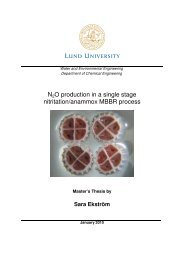Alexander Szabo and Oscar Engle - Svenskt Vatten
Alexander Szabo and Oscar Engle - Svenskt Vatten
Alexander Szabo and Oscar Engle - Svenskt Vatten
Create successful ePaper yourself
Turn your PDF publications into a flip-book with our unique Google optimized e-Paper software.
COD concentration, theoretical=er channels contributes with 60-90% of the total incoming<br />
water to the WSP. It can be seen on the velocity measurements that soon after the rainfall occur,<br />
the flow speed increases rapidly. As the rainfall ends, the flow tends to go down quickly. On the<br />
18-19 of November, most students left UTM for holiday. Approximately one half to two thirds of<br />
all students were not at the University during these measurements. Despite this, both Q max <strong>and</strong><br />
Q min (Table 8.4) were higher during the holiday than during the school period. This could be<br />
explained by that the monsoon period started just after the measurements on the 5-6 November,<br />
but before the 18 th of November. More or less every day received heavy rainfalls which could<br />
have raised the groundwater level, thus creating more infiltration into the sewer system. Since the<br />
storm water channels are built to receive all the storm water, no additional water should enter the<br />
sewage network. If the infiltrated water could be reduced, the HRT in the WSP would increase,<br />
hence improving the treatment efficiency. An unavoidable effect of reducing the infiltration is the<br />
increase in concentrations of pollutants in the waste water. It is however preferable to receive<br />
smaller quantities of waste water, even if the concentrations of pollutants are higher, since with<br />
effective reduction the total load of pollutants on the recipient will be lower than with diluted<br />
waste water.<br />
Sampling procedure for influent water<br />
The influent water was collected every two hours during the measurement periods. Samples were<br />
withdrawn from the inlet chamber <strong>and</strong> immediately taken to the laboratory <strong>and</strong> stored in a<br />
refrigerator.<br />
The first sampling started 5 th November at 17:30 <strong>and</strong> continued every second hour until 14:15 the<br />
next day. The second sampling started at 12:30 a.m. on the 18 th of November <strong>and</strong> continued every<br />
second hour until 10:00 a.m. the next day. The third sampling started at 12:00 a.m. on the 9 th of<br />
January <strong>and</strong> continued every second hour to 10:00 a.m. the 10 th of January.<br />
From all these samplings days COD, BOD 5 <strong>and</strong> TSS were analyzed according to the methods<br />
described in chapter 7. From the samples 5-6 November k-values were analyzed. Since the<br />
measurements during 5-6 November lacks flow data between 17:30 <strong>and</strong> 22:00, a designed flow<br />
was created <strong>and</strong> used in order to get complete measuring data <strong>and</strong> to calculate weighted<br />
parameters (see Figure 8.10).<br />
BOD 5 <strong>and</strong> COD in influent water<br />
The inlet COD concentrations show a tendency to rise when people use water consuming<br />
facilities at most, usually in the morning <strong>and</strong> late afternoon. When water flow increases due to<br />
rainfall, the COD values peaks <strong>and</strong> reaches levels much higher than during normal flow. At late<br />
night or early morning (04:00-06:00) all three sampling periods reach their lowest values (12 mg/l<br />
– 33 mg/l) (Figure 8.11). The pattern of COD concentrations is lower during the holiday period,<br />
which is explained by the lower load due to absence of students in combination with infiltration.<br />
According to Mara (2003), a COD concentration of less than 400 mg/l is considered as “weak<br />
strength”. This water is therefore placed into this category.<br />
From the first sampling period 5-6 November, BOD 5 from all 12 measurements were analyzed.<br />
For all 12 measurements that period, COD was also analyzed. This was done in order to get a<br />
<br />
48















